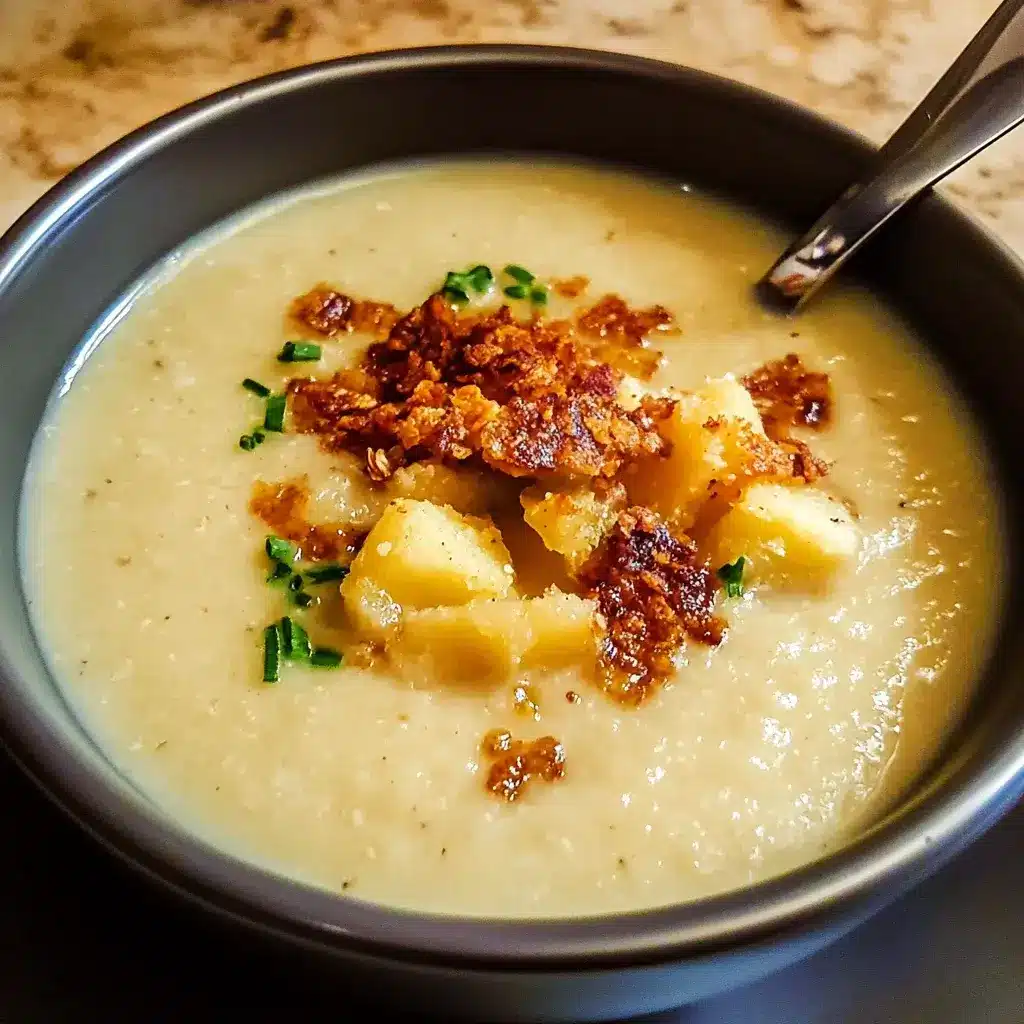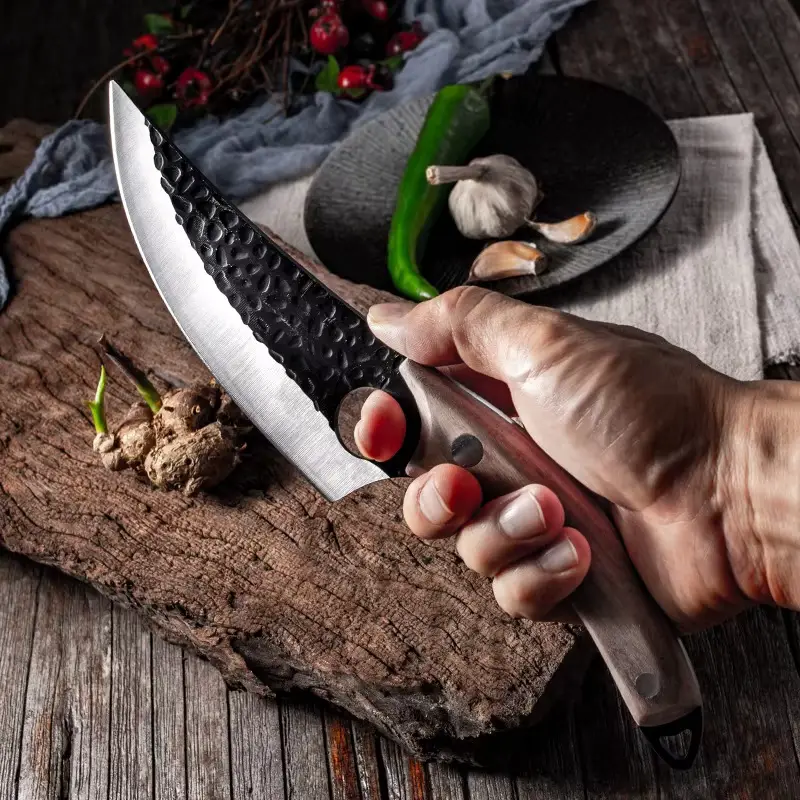There are some dishes that are more than just food; they are a feeling. For me, Parsnip and Potato Soup is the culinary equivalent of putting on a warm, cashmere sweater on a cold, rainy day. I first made this soup on a whim, having bought a bundle of beautiful, cream-colored parsnips at the farmers market with no real plan for them. They sat on my counter next to a bag of potatoes, and a simple idea sparked. I had always found parsnips to be the underrated cousin of the carrot—sweet, a little spicy, and wonderfully nutty. I wondered if their unique flavor could be the star of a soup, with the humble potato playing the perfect supporting role, lending its creamy, comforting texture. The result was nothing short of a revelation. The aroma that filled my kitchen was incredible—sweet, earthy, and deeply savory. The first spoonful was velvety smooth, a perfect balance of the parsnip’s gentle sweetness and the potato’s comforting richness, all elevated by the subtle perfume of leeks and thyme. It became an instant classic in my home, the soup my family requests the moment the leaves start to turn gold. It’s elegant enough for a holiday dinner party starter but simple and hearty enough for a quiet weeknight meal with a side of crusty bread. This recipe is my perfected version, a tribute to the simple magic of root vegetables.
The Ultimate Creamy Parsnip and Potato Soup Recipe
This soup is a celebration of winter root vegetables. The magic of this recipe lies in its beautiful simplicity and the depth of flavor you can achieve with just a handful of quality ingredients. The natural sweetness of the parsnips is perfectly balanced by the earthy, starchy creaminess of the potatoes. We use leeks instead of onions for their milder, more delicate flavor, which complements the parsnips without overpowering them. A touch of fresh thyme adds a woody, aromatic note that ties everything together. The final soup is velvety, luxurious, and deeply satisfying—a true hug in a bowl.
The Core Ingredients for a Perfect Soup
Gathering the right ingredients is the first step toward a flawless soup. Quality and freshness are key to bringing out the best in these simple components.
- Parsnips: 1.5 pounds (about 680g), peeled and roughly chopped (about 4-5 medium parsnips). Look for firm, small to medium-sized parsnips, as very large ones can sometimes have a tough, woody core.
- Potatoes: 1 pound (about 450g) Yukon Gold or Russet potatoes, peeled and roughly chopped (about 2-3 medium potatoes). Yukon Golds will lend a more buttery flavor and creamy texture, while Russets will make the soup exceptionally thick and fluffy.
- Leeks: 2 large, white and light green parts only. Leeks provide a sweeter, more subtle allium flavor than onions. It is crucial to clean them thoroughly.
- Unsalted Butter: 3 tablespoons. You can substitute with olive oil for a dairy-free version.
- Garlic: 4 cloves, smashed or roughly chopped.
- Broth: 6 cups of low-sodium vegetable or chicken broth. High-quality broth will make a significant difference in the final flavor.
- Heavy Cream: ½ cup. For a richer, more luxurious finish. You can substitute with full-fat canned coconut milk for a vegan alternative.
- Fresh Thyme: 4-5 sprigs. Fresh thyme has a much more potent and nuanced flavor than dried.
- Salt: 1 teaspoon, plus more to taste.
- Freshly Ground Black Pepper: ½ teaspoon, plus more to taste.
- Optional Garnish: A tiny pinch of freshly grated nutmeg.
Step-by-Step Instructions for Velvety Perfection
Follow these detailed steps to achieve a perfectly smooth, flavorful, and comforting soup every time. The key is in building layers of flavor from the very beginning.
1. Prepare and Clean Your Vegetables:
First, prepare your vegetables. Peel the parsnips and potatoes and chop them into uniform, 1-inch pieces. This ensures they will cook evenly. Now, for the leeks—this is a critical step. Leeks are notorious for trapping dirt and grit between their layers. To clean them properly, slice them in half lengthwise. Then, holding them under cold running water, fan the layers apart to wash away any hidden dirt. Once clean, thinly slice the white and light green parts. Discard the tough, dark green tops (or save them for making vegetable stock).
2. Sauté the Aromatics (The Flavor Base):
In a large, heavy-bottomed pot or Dutch oven, melt the 3 tablespoons of butter over medium heat. Once the butter is melted and foaming, add the sliced leeks. Sauté for about 8-10 minutes, stirring occasionally, until the leeks are very soft, wilted, and slightly sweet. Do not let them brown, as this will create a bitter taste. The goal is to sweat them to release their sugars. Add the 4 cloves of smashed garlic and cook for another minute until fragrant.
3. Cook the Root Vegetables:
Add the chopped parsnips and potatoes to the pot with the softened leeks. Stir everything together and cook for about 5 minutes, allowing the vegetables to get coated in the butter and start to absorb the flavors from the aromatics. This initial sauté helps to build another layer of flavor.
4. Simmer the Soup:
Pour in the 6 cups of broth and add the fresh thyme sprigs. Season with 1 teaspoon of salt and ½ teaspoon of black pepper. Turn the heat up to high and bring the soup to a boil. Once it’s boiling, reduce the heat to low, cover the pot, and let it simmer gently for 20-25 minutes. The soup is ready for the next step when the parsnips and potatoes are completely tender and can be easily pierced with a fork.
5. Blend to a Silky Smooth Consistency:
Remove the pot from the heat and fish out the woody thyme stems, leaving behind any leaves that have fallen off. Now it’s time to blend. You have two options:
- Using an Immersion Blender: This is the easiest method. Simply insert the immersion (or “stick”) blender directly into the pot and blend until the soup is completely smooth and velvety. Be sure to move the blender around the pot to get every last chunk.
- Using a Standard Blender: This method can yield an even silkier result but requires caution. Carefully ladle the soup into the blender in batches—never fill the blender more than halfway with hot liquid. Remove the small plastic cap from the blender lid and cover the opening with a folded kitchen towel. This allows steam to escape and prevents a dangerous pressure buildup. Hold the lid down firmly while you blend each batch until smooth. Pour the blended soup into a clean pot or a large bowl.
6. Add the Finishing Touches:
Once all the soup is blended and smooth, stir in the ½ cup of heavy cream (or coconut milk). Stir until it is fully incorporated. Do this off the heat to prevent the cream from curdling. Taste the soup and adjust the seasoning as needed, adding more salt and pepper to your preference. For the secret finishing touch, grate a tiny pinch of fresh nutmeg over the soup and stir it in. This subtly enhances the natural nutty sweetness of the parsnips.
7. Serve and Enjoy:
Ladle the warm, creamy soup into bowls. Garnish as desired (see our serving suggestions below) and serve immediately with a side of crusty bread for dipping.
Nutrition Facts: A Wholesome Bowl
This soup is not only comforting but also packed with nutrients from the root vegetables. Here is an estimated nutritional breakdown.
- Servings: This recipe makes approximately 6-8 servings.
- Calories per serving: Approximately 250-320 kcal (this will vary based on the type of potatoes, broth, and whether you use cream or a substitute).
Disclaimer: This is an estimate. Actual nutritional content will vary based on the specific ingredients used.
Parsnips are an excellent source of fiber, Vitamin C, Vitamin K, and folate. Potatoes provide potassium and Vitamin B6. By making this soup from scratch, you control the sodium content, making it a much healthier choice than canned soups.
Timing Your Comfort: Preparation and Cook Time
This elegant soup comes together surprisingly quickly, making it perfect for both weeknights and special occasions.
- Preparation Time: 20 minutes (This includes washing, peeling, and chopping all the vegetables).
- Cook Time: 35-40 minutes
- Total Time: Approximately 1 hour
The Art of Serving: Garnishes and Pairings
A great garnish can transform a simple bowl of soup into a stunning dish. Here are some ideas for serving your Parsnip and Potato Soup, along with perfect pairings.
Delicious Garnish Ideas:
- For Crunch:
- Homemade Croutons: Toss cubes of day-old bread with olive oil, salt, and garlic powder and bake until golden.
- Crispy Bacon or Pancetta: Crumble cooked bacon or crispy pancetta over the top for a salty, savory crunch.
- Toasted Nuts or Seeds: Toasted walnuts, pecans, or pumpkin seeds add a lovely nutty texture.
- Crispy Fried Leeks or Shallots: Thinly slice leeks or shallots, toss in a little flour, and fry until golden brown.
- For Richness and Color:
- A Swirl of Cream or Olive Oil: A simple drizzle of heavy cream, crème fraîche, or a high-quality extra virgin olive oil looks elegant.
- Fresh Herbs: A sprinkle of finely chopped chives or fresh parsley adds a pop of green and a fresh, oniony bite.
- A Pinch of Spice: A light dusting of smoked paprika or cayenne pepper adds color and a hint of warmth.
Perfect Pairings:
- Crusty Bread: This is non-negotiable! A warm baguette, a slice of sourdough, or a hearty multigrain bread is essential for dipping.
- Gourmet Grilled Cheese: Elevate the classic soup-and-sandwich combo with a grilled cheese made with Gruyère or sharp cheddar on sourdough.
- A Simple Green Salad: A lightly dressed salad with a bright, acidic vinaigrette provides a fresh contrast to the rich, creamy soup.
- As a First Course: Serve smaller portions of this soup as an elegant starter for a holiday meal, such as a roast chicken or beef tenderloin dinner.
Pro-Level Secrets: 5 Additional Tips for the Best Soup
Take your soup from delicious to unforgettable with these five professional tips.
1. Roast the Vegetables First for Deeper Flavor:
For an even more intense, complex, and sweet flavor, roast your parsnips and potatoes before adding them to the pot. Toss the chopped vegetables with olive oil, salt, and pepper, spread them on a baking sheet, and roast at 400°F (200°C) for 20-25 minutes, until tender and lightly caramelized. Then, add them to the pot with the sautéed leeks and proceed with the recipe. This caramelization adds a deep, roasted nuttiness that is absolutely incredible.
2. The Secret Ingredient: A Pear or Apple:
To subtly enhance the natural sweetness of the parsnips and add a layer of fruity complexity, add one peeled, cored, and chopped pear (like a Bosc or Anjou) or apple (like a Granny Smith for tartness or a Gala for sweetness) to the pot along with the potatoes and parsnips. It will melt into the soup and you won’t be able to identify it, but it will lend a beautiful, bright background note.
3. Don’t Boil the Cream:
This is a crucial technical tip. Always add your heavy cream or coconut milk at the very end, after you have removed the soup from the heat. Boiling dairy can cause it to curdle or separate, resulting in a grainy texture. Stir it in gently off the heat to ensure your soup remains perfectly silky and smooth.
4. For an Extra-Velvety Texture, Use a Sieve:
If you are aiming for a truly luxurious, restaurant-quality, ultra-silky soup, take one extra step after blending. Place a fine-mesh sieve over a clean pot and pour the blended soup through it, using the back of a ladle to push the liquid through. This will catch any remaining fibrous bits from the parsnips or any small lumps, guaranteeing the smoothest possible texture.
5. Save the Leek Greens and Vegetable Peels for Stock:
Don’t throw away the dark green tops of the leeks or the peels from your parsnips and potatoes (as long as they are well-scrubbed). You can place them in a freezer bag and save them. Once you have a full bag, you can use them to make a flavorful, free homemade vegetable stock for your next batch of soup!
Your Questions Answered: Frequently Asked Questions (FAQ)
Here are the answers to some common questions about making Parsnip and Potato Soup.
1. Can I make this soup vegan and dairy-free?
Yes, absolutely! This recipe is very easy to adapt. To make it vegan, simply use olive oil instead of butter for sautéing, ensure you are using vegetable broth, and substitute the heavy cream with an equal amount of full-fat canned coconut milk or a homemade cashew cream. The full-fat coconut milk will add a lovely richness and a very subtle coconut flavor that pairs beautifully with the parsnips.
2. My soup is too thick (or too thin). How can I fix it?
This is an easy fix! If your soup is too thick for your liking, simply stir in a little more broth until it reaches your desired consistency. If your soup is too thin, you can let it simmer uncovered on low heat for 10-15 minutes to allow some of the liquid to evaporate and thicken it up naturally.
3. How do I store and reheat leftover soup?
Store any leftover soup in an airtight container in the refrigerator for up to 4-5 days. The soup will thicken as it cools. To reheat, pour it into a saucepan and warm it gently over medium-low heat, stirring occasionally, until it is heated through. Avoid boiling the soup during reheating, especially after the cream has been added.
4. Can I freeze Parsnip and Potato Soup?
Yes, you can freeze this soup, but with a small caveat. Soups containing potatoes and dairy can sometimes have a slightly grainy texture upon thawing. For the best results, follow the recipe up to the point before adding the cream. Let the blended soup cool completely, then freeze it in airtight, freezer-safe containers for up to 3 months. When you’re ready to eat, thaw the soup overnight in the refrigerator, reheat it gently on the stove, and then stir in the fresh cream just before serving.
5. My parsnips have a woody core. Should I remove it?
If you are using very large, older parsnips, they can sometimes develop a tough, woody core in the center. If you notice this when you chop them, it’s best to remove it. You can do this by quartering the parsnip lengthwise and simply cutting away the fibrous central core. This core will not soften during cooking and can make your final soup fibrous instead of smooth. Smaller, younger parsnips typically do not have this issue.

Parsnip Potato Soup recipe
Ingredients
- Parsnips: 1.5 pounds (about 680g), peeled and roughly chopped (about 4-5 medium parsnips). Look for firm, small to medium-sized parsnips, as very large ones can sometimes have a tough, woody core.
- Potatoes: 1 pound (about 450g) Yukon Gold or Russet potatoes, peeled and roughly chopped (about 2-3 medium potatoes). Yukon Golds will lend a more buttery flavor and creamy texture, while Russets will make the soup exceptionally thick and fluffy.
- Leeks: 2 large, white and light green parts only. Leeks provide a sweeter, more subtle allium flavor than onions. It is crucial to clean them thoroughly.
- Unsalted Butter: 3 tablespoons. You can substitute with olive oil for a dairy-free version.
- Garlic: 4 cloves, smashed or roughly chopped.
- Broth: 6 cups of low-sodium vegetable or chicken broth. High-quality broth will make a significant difference in the final flavor.
- Heavy Cream: ½ cup. For a richer, more luxurious finish. You can substitute with full-fat canned coconut milk for a vegan alternative.
- Fresh Thyme: 4-5 sprigs. Fresh thyme has a much more potent and nuanced flavor than dried.
- Salt: 1 teaspoon, plus more to taste.
- Freshly Ground Black Pepper: ½ teaspoon, plus more to taste.
- Optional Garnish: A tiny pinch of freshly grated nutmeg.
Instructions
1. Prepare and Clean Your Vegetables:
First, prepare your vegetables. Peel the parsnips and potatoes and chop them into uniform, 1-inch pieces. This ensures they will cook evenly. Now, for the leeks—this is a critical step. Leeks are notorious for trapping dirt and grit between their layers. To clean them properly, slice them in half lengthwise. Then, holding them under cold running water, fan the layers apart to wash away any hidden dirt. Once clean, thinly slice the white and light green parts. Discard the tough, dark green tops (or save them for making vegetable stock).
2. Sauté the Aromatics (The Flavor Base):
In a large, heavy-bottomed pot or Dutch oven, melt the 3 tablespoons of butter over medium heat. Once the butter is melted and foaming, add the sliced leeks. Sauté for about 8-10 minutes, stirring occasionally, until the leeks are very soft, wilted, and slightly sweet. Do not let them brown, as this will create a bitter taste. The goal is to sweat them to release their sugars. Add the 4 cloves of smashed garlic and cook for another minute until fragrant.
3. Cook the Root Vegetables:
Add the chopped parsnips and potatoes to the pot with the softened leeks. Stir everything together and cook for about 5 minutes, allowing the vegetables to get coated in the butter and start to absorb the flavors from the aromatics. This initial sauté helps to build another layer of flavor.
4. Simmer the Soup:
Pour in the 6 cups of broth and add the fresh thyme sprigs. Season with 1 teaspoon of salt and ½ teaspoon of black pepper. Turn the heat up to high and bring the soup to a boil. Once it’s boiling, reduce the heat to low, cover the pot, and let it simmer gently for 20-25 minutes. The soup is ready for the next step when the parsnips and potatoes are completely tender and can be easily pierced with a fork.
5. Blend to a Silky Smooth Consistency:
Remove the pot from the heat and fish out the woody thyme stems, leaving behind any leaves that have fallen off. Now it’s time to blend. You have two options:
- Using an Immersion Blender: This is the easiest method. Simply insert the immersion (or “stick”) blender directly into the pot and blend until the soup is completely smooth and velvety. Be sure to move the blender around the pot to get every last chunk.
- Using a Standard Blender: This method can yield an even silkier result but requires caution. Carefully ladle the soup into the blender in batches—never fill the blender more than halfway with hot liquid. Remove the small plastic cap from the blender lid and cover the opening with a folded kitchen towel. This allows steam to escape and prevents a dangerous pressure buildup. Hold the lid down firmly while you blend each batch until smooth. Pour the blended soup into a clean pot or a large bowl.
6. Add the Finishing Touches:
Once all the soup is blended and smooth, stir in the ½ cup of heavy cream (or coconut milk). Stir until it is fully incorporated. Do this off the heat to prevent the cream from curdling. Taste the soup and adjust the seasoning as needed, adding more salt and pepper to your preference. For the secret finishing touch, grate a tiny pinch of fresh nutmeg over the soup and stir it in. This subtly enhances the natural nutty sweetness of the parsnips.
7. Serve and Enjoy:
Ladle the warm, creamy soup into bowls. Garnish as desired (see our serving suggestions below) and serve immediately with a side of crusty bread for dipping.
Nutrition
- Serving Size: one normal portion
- Calories: 250-320 kcal






